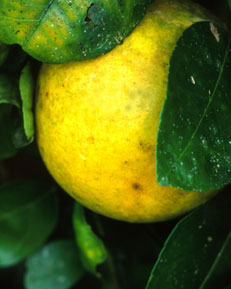
Photo © Steven Foster
Introduction
The largest citrus fruit commonly available is the grapefruit,1 which is a natural hybrid of pummelo and sweet orange.2,3,4 The tree is often over 33 feet high with glossy leaves and large, dimpled, round, yellowish fruits that are 3 to 6 inches in diameter.2,5 It is native to the tropical Malay Archipelago and West Indies, and extensively cultivated in Texas, Florida, California, Arizona, India, Brazil, Israel, Argentina, and South Africa.1,5,6 The whole fruit can be used, including the peel and seeds.
History and Cultural Significance
The grapefruit is the refined descendant of the bigger, rougher fruit called pummelo or shaddock.1 It is considered a “new world” product because it is only a few hundred years old.2 The first records of grapefruit were written in 1750 by Griffith Hughes who spoke of a “small shaddock” that was called “forbidden fruit” in Barbados.1,2,3,7 The grapefruit name was first recorded in 1814 in Jamaica possibly because the fruit clusters resemble grapes.1,2
Grapefruit is eaten fresh or made into desserts, and the peel can be candied.4 Grapefruit juice is a common beverage which can be made into wine or vinegar.4 Grapefruit used as a dietary supplement supplies potassium, vitamin C, and fiber.2,8 It is commonly believed to reduce cholesterol and reverse plaque formation in the blood vessels.2,7,8 Historically, grapefruit has been used to aid in weight reduction (i.e., the “grapefruit diet”).8
Grapefruit seed oil can be refined for culinary purposes.4 Grapefruit peel oil is mainly used to flavor soft drinks and other beverages.4,5,9 It is used in the food industry to blend and modify other flavors.3 Its primary application in perfumery is as a modifier for other citrus compositions.3,9 Grapefruit peel oil is used as a fragrance in soaps, detergents, cosmetics, perfumes and men’s colognes.3,5,8 It is also utilized in air deodorizers and disinfectants.10 Grapefruit peel oil has tonic, refreshing, and exfoliating properties which makes it a popular ingredient in creams and lotions.6 Historically, grapefruit peel oil has been used topically to relieve muscle fatigue, promote hair growth, tone skin, and reduce acne and oily skin.8 It has also been inhaled to help the body retain water, to treat the common cold and flu, and to relieve headache, stress, and depression.8 Chemical compounds called liminoids in the peel deter insects and parasites, and are nontoxic to warm-blooded animals.11
Grapefruit seed extract is employed in household cleansers.8 Agricultural uses include as a bactericide, fungicide, mold inhibitor, antiparasitic, food preservative, antioxidant, and water disinfectant.8 Grapefruit seed extract has been used externally for warts, athlete’s foot, dandruff, and poison oak,7 and topically as a facial cleanser, for mild skin irritations and first aid, as an ear and nasal rinse, throat gargle, dental rinse, vaginal douche, antiseptic for wounds, and drug and poison eliminator.7,8 Traditionally it has been used internally to treat diarrhea, allergies, flu, strep throat, to prevent or treat infection, and to remove or dissolve inorganic calcium that may have deposited in joints (arthritis).7,8
Traditional uses of grapefruit in aromatherapy are for skin care, reducing cellulite, exercise preparation, muscle fatigue, obesity, water retention, depression, headache, nervous exhaustion, performance stress and for boosting the immune system.5
Modern Research
Most studies currently done on grapefruit involve drug interactions with existing and upcoming medications. One investigation showed that inhaling grapefruit essential oil will produce an increased response in the sympathetic nervous system (which helps prepare the body for situations of stress and emergency) in adults.12 A laboratory study demonstrated that grapefruit essential oil, alone or in combination with other essential oils, has antibacterial properties that may be useful in wound care.13
Future Outlook
The U.S. is the world’s leading grapefruit producer (40%), with China ranked second.14 U.S. production has been declining at 6 percent annually since 2000, causing world production to decrease. U.S. decline in production is due to decrease in demand for grapefruit, most likely because of an increase in fruit variety availability, inconvenience of grapefruit consumption, and increased awareness of drug interactions with grapefruit products. Two of the major hurricanes in 2004 that hit Florida, the leading grapefruit producer in the U.S., significantly damaged many grapefruit crops which will affect overall U.S. production for years to come. The U.S. is becoming more reliant on export markets for sales. Production has increased 15 percent annually in China and 10 percent annually in South Africa which may affect the U.S. market.14
References
1 Davidson A. The Oxford Companion to Food. London: Oxford University Press; 1999.
2 DerMarderosian A, Beutler J, eds. The Review of Natural Products. St. Louis, MO: Facts and Comparisons; 2002.
3 Dugo G, Di Giacomo A, eds. Citrus: The genus Citrus. New York: Taylor and Francis Inc; 2002.
4 Facciola S. Cornucopia: A Source Book of Edible Plants. Vista, CA: Kampong Publications; 1990.
5 Lawless J. The Illustrated Encyclopedia of Essential Oils: The Complete Guide to the Use of Oils in Aromatherapy and Herbalism. Dorset, UK: Element Books, Ltd; 1995.
6 D’Amelio FS. Botanicals: A Phytocosmetic Desk Reference. Boca Raton, FL: CRC Press LLC; 1999.
7 Onstad D. Whole Foods Companion: A Guide for Adventurous Cooks, Curious Shoppers & Lovers of Natural Foods. White River Junction, VT: Chelsea Green Publishing Company; 1996.
8 Jellin JM, ed. Natural Medicines Comprehensive Database. Stockton, CA: Therapeutic Research Faculty; 2002.
9 Arctander S. Perfume and Flavor Materials of Natural Origin. Carol Stream, IL: Allured Publishing Corporation; 1994.
10 Schnaubelt K. Medical Aromatherapy: Healing with Essential Oils. Berkeley, CA: Frog, Ltd; 1999.
11 Lewis WH, Elivin-Lewis MPF. Medical Botany: Plants Affecting Human Health. 2nded. Hoboken, NJ: John Wiley and Sons, Inc; 2003.
12 Haze S, Sakai K, Gozu Y. Effects of fragrance inhalation on sympathetic activity in normal adults. Jpn J Pharmacol. 2002 Nov;90(3):247-253.
13 Edwards-Jones V, Buck R, Shawcross SG, Dawson MM, Dunn K. The effect of essential oils on methicillin-resistant Staphylococcus aureus using a dressing model. Burns. 2004 Dec;30(8):772-777.
14 Economic Research Service, USDA. Fruit and Tree Nuts Outlook/FTS-314/January 27,2005. Available at http://www.ers.usda.gov/Briefing/FruitAndTreeNuts/fruitnutpdf/grapefruit.pdf. Accessed September 5,2005.
|